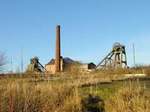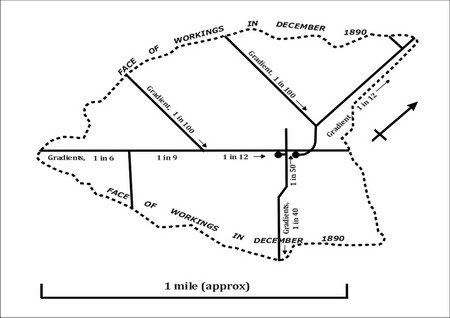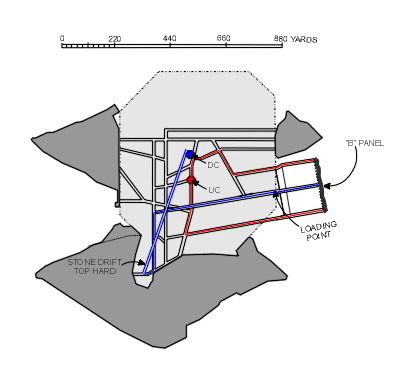
Technical > Under-ground

Section under repair
Contents:
- > introduction
- > the pit bottoms
- > the working seams
- > the cross-measure drifts
- > the working districts
- > the transport systems
- > the ventilation
From the sinking until the deepening of the South shaft in 1920, all production was obtained from the Top Hard seam. The pit bottoms were originally laid out for coal winding at the North shaft only. Although the South shaft was fitted up in 1888 to allow coal winding - at a restricted volume, the pit bottom layout seems to have remained essentially the same. In 1900 when the South headstock and coal winding was being altered, production was maintained by two shift winding at the North pit. When the North headstock was changed in 1901, however, the reverse could not be done since the arrangement of the pit bottom roadways was not suitable. This layout continued until 1919 when a new road was driven to the North pit bottom in readiness for the deepening of the South shaft.
The faces in the Top Hard seam were operated on the longwall system and worked by hand. Explosives were not used in coal extraction but only for drivage work in stone.

Layout of Top Hard main roadways circa 1890
Although the South shaft was deepened to the Black Shale seam it was decided to work the Deep Hard seam and a large inset was constructed at this level to allow simultaneous loading of three deck cages. A cross-measures drift was constructed between the Top Hard and Deep Hard seams to act as the main intake airway and second means of egress.
The faces in the Deep Hard were opened out on the longwall system and were originally worked by hand. They were laid out on the cross i.e. so that the orientation of the face was part way between that of the main and the end cleat (the existing vertical cleavage planes in the coal - approximately at right angles to each other). This orientation helped the coal to break into the large lumps preferred for house and steam coal.
With the introduction of power loading the orientation relative to the cleat became less important and the faces were laid out on a rectilinear pattern to obtain maximum extraction

Layout of Deep Hard main roadways, hand worked areas and first mechanised face circa 1945
....to be continued....
TOP
Copyright © 2023 J.S. Thatcher
Page updated on:
11 Nov, 2023
at
05:24:42 PM
In case of problems contact: